1905 Souvenir of Greenville
 Bird's Eye View of Greenville, Illinois, as it appeared in 1905
Bird's Eye View of Greenville, Illinois, as it appeared in 1905
Foreward
In presenting this little volume to the critical gaze of the people of
Greenville, the author fully realizes that there are many of her citizens who
are better equipped by tenure of years and by ripe experience to lay bare the
story of her life and growth.
The task of assembling the historical data has been a great one, but when once
assembled, the work of confining it to a volume the size of this, without losing
sight of the essential facts, was even greater. In order to confine the story of
Greenville to a volume of this size it became necessary to treat the subject in
a general way. This was never intended to be a biographical record, but a
history of Greenville could not be written without frequent illusions to many of
her citizens who have contributed materially to her growth, perhaps mention of
some of these has been omitted. If so, it is unintentional.
The illustrating of this book has been conducted by Mr. Byron K. LeCrone, of
Effingham, and Mr. Lon S. Matherly, of Vandalia. The people of Greenville have
responded most generously in many ways to make this work a success. To single
out any one individual, or, for that matter, any dozen individuals, as having
given valuable assistance in this work, would be to overlook scores of others,
who have done equally as much. Of course there have been some who have
contributed vastly more than others in its compilation, but to the whole people
we are indebted for whatever measure of success this little book attains and to
them we wish to express our sincere appreciation.
Will C. Carson.
Greenville, Illinois, December 15, 1905.
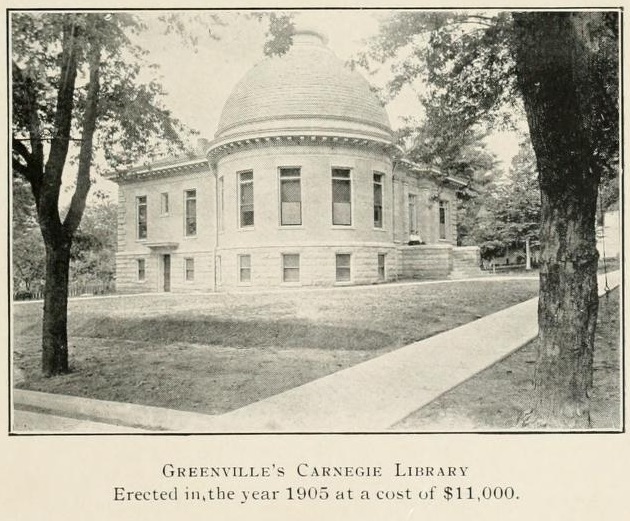 Greenville's Carnegie Library
Greenville's Carnegie Library
Erected in. the year 1905 at a cost of $11,000.
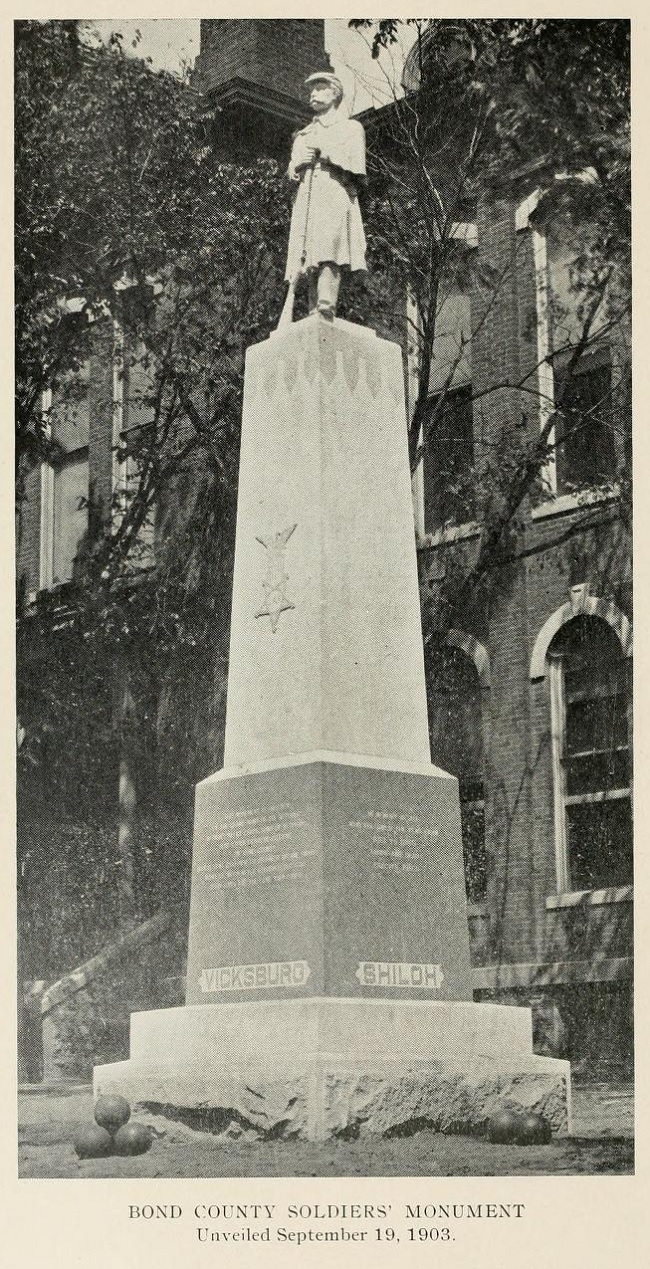 Bond County Soldiers' Monument
Bond County Soldiers' Monument
Unveiled September 19, 1903.
A Condensed History of Greenville, Illinois
Countless changes have taken place in the ninety years that have elapsed since a
lone log cabin, on the brow of the hill at the west end of present Main Avenue,
constituted the whole of Greenville. In those good old days of 1815, when
Greenville was young, the public road ran past the cabin, and down the hill,
and, crossing the creek at the Alton ford, was swallowed up by the forest.
Truthfully to relate how Greenville, from that rudely constructed log cabin,
steadily advanced through the years and has earned her place on the map, and how
she has been evolved from the forest primeval into a bustling city of twentieth
century attainments, is to tell again the story of the unspeakable hardships of
the pioneers, and of the determination of the settlers, who followed them.
It was ninety years ago that a sturdy pioneer, by name George Davidson,
attracted by the rolling hills and clear spring water, set about to clear the
forest and make himself a home, and, camping on the edge of the big ravine that
yawns about the western confines of the town, he paved the way for a "Greater
Greenville."
The history of Greenville, the third and present county seat of Bond county, is
so closely interwoven with the history of the county itself, that a slight
digression is here and now pardonable, that we may, at the outset, note the
beginnings of the then new country of the Northwest Territory, of which Bond
county, and by inference, Greenville, formed no insignificant part.
Wrested from the clutches of Great Britain by the indomitable will of George
Rogers Clark, to whom we of today owe a mighty debt of gratitude, the Illinois
country became a county of Virginia in 1778 and so remained until the deed of
session of 1784, and from that time on the great territory of Illinois was pared
down until it reached its present dimensions, and the great, overgrown county of
Bond, that then extended to the shores of Lake Michigan, the fifteenth county to
be formed, gave generously of its territory to the formation of Montgomery,
Fayette and Clinton counties: in fact so liberally that it was finally compelled
to borrow from Madison, in sheer self-defense, finding itself shaved down to its
present unpretentious dimensions. Beyond a doubt the spirit of broad-mindedness
and liberality that now characterizes the county and city was born of that
period.
Bond county was organized in 1816 and was named for Shadrach Bond, the first
governor of Illinois. It was one of the original fifteen counties represented in
the Constitutional Convention of 1818. Thos. Kirkpatrick and Samuel G. Morse
represented the county in the convention that formed the first state
constitution. At this election for conventioners there were three candidates,
Morse, Kirkpatrick and Martin, although but two were to be elected. The issue
was slavery or no slavery. Morse and Kirkpatrick were against slavery but Martin
was noncommittal. Some lively Tennesseeans concocted a scheme to ascertain
Martin's views. They called him to one side and told him that they, as well as
some of their friends in Tennessee, wanted slavery admitted so that they might
bring their slaves here. Their plan was successful, for Martin said, "Boys,
don't say anything, but I am for slavery."
The boys did say something, however, and Martin was defeated. George Davidson,
founder of Greenville, was one of the clerks at this election.
In giving of her territory and in being represented at the first constitutional
convention, Bond county is justly entitled to be denominated one of the corner
stones on which has been laid the superstructure of present day prosperity of
the great northwest.
Early Settlements.
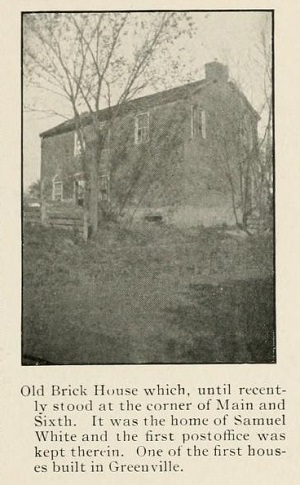 Old Brick House which, until recently stood at the corner of Main and Sixth. It
was the home of Samuel White and the first postoffice was kept therein. One of
the first houses built in Greenville.
Old Brick House which, until recently stood at the corner of Main and Sixth. It
was the home of Samuel White and the first postoffice was kept therein. One of
the first houses built in Greenville.

Cyrus Birge, Deceased.
Greenville Merchant in 1824.
Permanent settlement of Bond county was made prior to 1811, but the exact date
is not fixed. Mrs. Elizabeth Harbour, who lived at Chatham, Illinois in 1890,
declared that her family settled near Greenville in 1808, and that there had
been white settlers before them. The lady named Isaac Hill, Tom Ratan, Billy
Jones, John Finley and Henry Cox as having been here at that time. It is an
established fact that settlement was made at Hill's Fort in the summer 1811.
This fort covered an acre of ground and was situated on the present farm of John
O'Byrne, eight miles southwest of present Greenville. The mother of James H.
White, of Greenville, was an inmate of this fort, her father having taken her
there for safety.
In early days the Indians made annual incursions into the country in and around
Greenville. They usually came in the autumn, because they then could get game
and corn on which to subsist. A mile and a half south of Hill's Fort was Jones'
Fort, built about the same time. These two feeble bands of settlers, at that
time, composed the entire population of Bond county. These forts were not only a
place of defense but the residence of the families belonging to the
neighborhood. The stockades, bastions, cabins and block house walls had port
holes at proper heights and distances. The whole of the outside was made
absolutely bullet proof and the fort was built without the use of a single nail
or spike.
Some families were so attached to their farms that they remained on them as much
as possible, despite the constant danger of an Indian attack. In the event of
the approach of Indians, an "express" from the fort was sent out to arouse the
settlers, who at once hastened to the stockade and thus it often happened that
the whole number of families belonging to a fort, who were in the evening at
their homes, were all in the fortress before dawn the next morning. During the
succeeding day their household effects were brought in by parties of armed men
sent out for that purpose. Some families were more foolhardy or adventurous than
others and in spite of every remonstrance they would remain on their farms, or,
if in the stockade, would return prematurely to their property, thus endangering
their lives.
The Cox Massacre.
The Cox massacre is frequently confused with the killing of Henry Cox and his
son, south of Greenville, by the Indians. Henry Cox and his son were killed and
by Indians, but the Cox massacre, which is commemorated by a monument in the
country west of Greenville, was the occasion of the death of another Cox, and
the taking into captivity of a young woman.
The Cox family moved from near Alton and settled north of Pocahontas a distance
of two miles. They had been there two or three years and were building a horse
mill at the time of the murder, which was on June 2, 1811. Several Indians of
the Pottawattomie tribe, having heard a considerable amount of money was in
possession of the family went to the cabin while the father and mother were
away. They killed the son, cutting out his heart and placing it on his head.
They then threatened his sister, Rebecca Cox, who had been a witness of the
terrible deed, with a like vengeance, unless she revealed the hiding place of
the money. The girl went to a chest, and fumbling around in it, in order to
conceal the principal packages, handed them a small parcel, which they accepted.
The Indians then stole the horses and taking the girl prisoner, started north up
the Shoal Creek timber. Rebecca was shrewd enough to tear strips from her apron
and drop them along the trail as a guide for her rescuers.
As soon as the family returned and found the mutilated corpse of their son lying
in the cabin, and the daughter gone, they went to Hill's Station, sent
messengers to alarm the settlers in Bond and Madison counties and as soon as
possible Captain Pruett, Davy White and seven others went in pursuit. The
Indians, having had several days start, were overtaken near where Springfield
now stands. The girl was tied on a pony. At sight of her rescuers, she loosed
her bands, jumped from the pony and started to meet them. An Indian threw a
tomahawk. It stuck squarely in her back and thus her saviours found her. The
girl afterward recovered, married and moved to Arkansas, where her husband was
killed by Indians. Three miles north of Pocahontas is the grave of Cox and above
it stands a monument erected by the people of that community a few years ago.
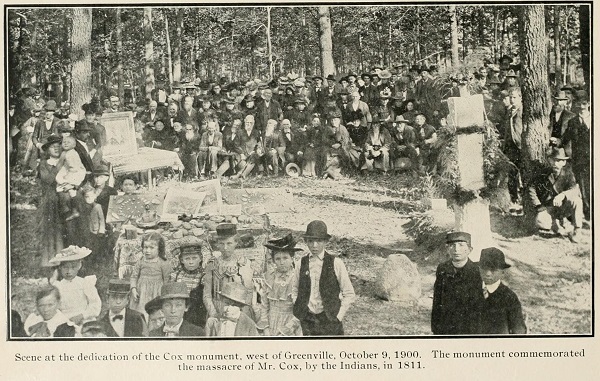
Scene at the dedication of the Cox monument, west of Greenville, October 9,
1900. The monument commemorated the massacre of Mr. Cox, by the Indians, in
1811.
The killing of Henry Cox by the Indians is an entirely different story. Cox was
an inmate of Hill's Fort but had built a cabin nearly a mile south of where
Dudleyville now stands. One morning in August, 1815, Cox took his son, aged 15,
and went, each on horseback, to his cabin. All appeared quiet when they rode up
to the cabin. Cox told his son to ride down to the creek and water the horses,
while, rifle in hand, he went to the door of the cabin. Pushing the door open,
he saw an Indian in the house. Quick as a flash he raised his rifle and fired.
He missed the Indian and his ball sunk in the log over the fireplace. At the
same instant another Indian, concealed behind a tree, fired at Cox, the ball
passing through his body and killing him instantly. Spattering the blood of Cox
all over the door, the bullet imbedded itself in the wood. The Indians then ran
to catch the boy with the horses and keep him from giving the alarm at the fort.
In their attempt to capture him they became alarmed at the delay and finally
shot him and buried him without going back to the body of his father. The boy
was not, found and it was believed that he was taken prisoner until after peace
was made, when the Indians revealed the fate of the boy. The bullet holes and
the splotch of Cox's blood on the cabin door were seen years afterward, when the
property was owned by Abraham McCurley.
There is a tradition, handed down by James Mc. Gillespie, who came to Bond
county in 1816, and who, in 1860, made written report of his reminiscenses to
the Old Settlers' Association, that one Benjamin Henson came to Bond sometime
before the war of 1812. Living in a hollow sycamore tree in Shoal Creek bottom,
he feared no man and was content. It is related that at one time during the war
of 1812, the forts were all abandoned on account of the Indian hostilities and
Henson alone was left in his 8 by 10 sycamore tree, the only white inhabitant of
the county. When the hostilities were over the settlers returned to find Henson
unmolested. Henson is said to have piloted people across Shoal Creek at the foot
of Mill Hill, Greenville, until the state, in 1824, gave $200 for a bridge to be
placed across the stream at that point.
Near Jones' fort, in those early days, an Indian concealed himself in the dense
foliage of a tree and picked off five men before he was discovered and shot. In
August 1814, Major Journey, in command of Hill's Fort, flung open the gates and
marched forth to look for Indians, leaving the garrison absolutely defenseless
and the women milking the cows. The Indians surprised them, killed the Major and
three of his men, and wounded the fifth, Thomas Higgins, whose escape was almost
miraculous.
These are some of the scenes that went toward the making of Greenville, and,
though the .graves of the heroes, who fell at Hill's Fort and Jones' Fort, less
than a hundred years ago, now go unmarked, the memory of their valorous deeds
sticks deep in our minds, for they blazed the way for the founding, only a few
miles to the northward, of the puny settlement, out of which our own fair city
of Greenville has been evolved.
At the close of our last war with England, a treaty of peace was made with the
Indians, the forts in Bond county were abandoned and straggling settlements
began to form. The settlers came but slowly however, and in 1816 Bond county
numbered but twenty-five cabins.
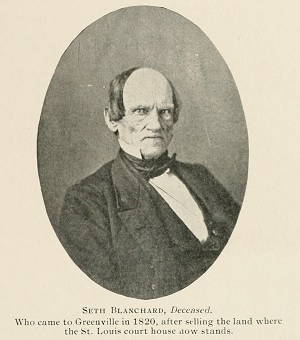
Seth Blanchard, Deceased.
Who came to Greenville in 1820, after selling the land where the St. Louis court
house now stands.

Willard Twiss, Deceased.
A Greenville Merchant of the Twenties, who employed John A. Logan as a jockey on
the farm now known as the A. J. Sherburne farm.
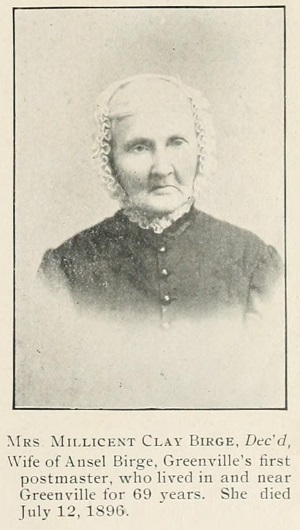
Mrs. Millicent Clay Birge, Dec'd.
Wife of Ansel Birge, Greenville's first postmaster, who lived in and near
Greenville for 69 years. She died July 12, 1896.

George Donnell, Deceased. Who came to Greenville in 1818, and who was one of the
pioneer residents.
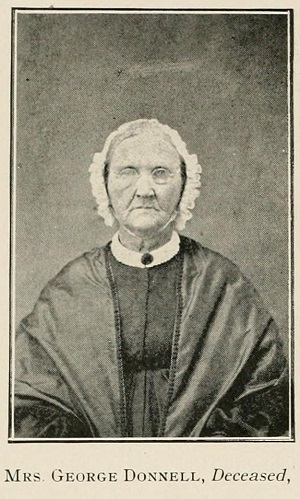
Mrs. George Donnell, Deceased.
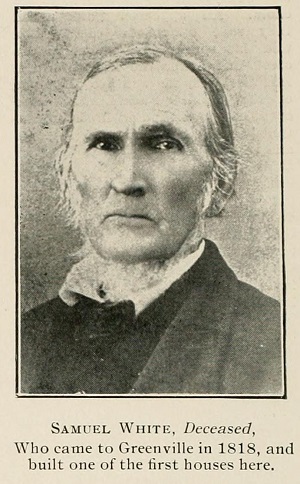
Samuel White, Deceased.
Who came to Greenville in 1818, and built one of the first houses here.
When Greenville was Young.
History bears evidence that great achievements are wrought through much
tribulation, and so it was in the founding of Greenville, for be it known that
milk-sickness in Madison county caused George Davidson to sell his farm there
and move to Bond county in 1815. The records show that he entered 160 acres of
land, where Greenville now stands, September 27, 1816. He obtained the patent
from His Excellency James Monroe, President of the United States, April 29,
1825. This land is described as the southeast quarter of Section No. 10,
Township 5, north, Range 3, west of the third principal meridian.
Mr. Davidson's cabin was built on the primitive style of logs with weight poles
to hold the clap-board roof in place. The puncheon floor was made of slabs,
split and hewn, and the carpenter had no use for nails, glass, putty, nor
plaster. Mr. Davidson's cabin was located in the extreme western part of town,
near the present residence of H. H. Staub. His family consisted of his wife,
Jannet, two sons and two daughters. One son, Samuel, died of consumption, soon
after coming here. One daughter, Mrs. Elizabeth Caroline Blundell, lived at
Healdsburg, California in 1876, and in a letter to one of the Greenville papers
stated that her brother and the Reverend Green P. Rice, who followed George
Davidson here, laid out some lots in the western part of Greenville. This plat
of the old town was never recorded and there is a story to the effect that
George Davidson, one day, in a fit of anger, tore the plat up and watched it
burn to ashes in the fireplace.
The existence of this plat afterwards made trouble for the people who purchased
lots, when the town was finally laid out. This part of the town, then laid out,
as the original town, is now Davidson's addition.
Not long after he built his first cabin, George Davidson moved to the lot at the
southwest corner of Sixth Street and Main Avenue (as it is today) directly
across the street south of the John Baumberger, Sr., homestead, and opened a
tavern. In opening the first tavern in Greenville, Mr. Davidson again proved
himself a public benefactor, for it was for many years a mecca for the wayfaring
man, as well as a most convenient loafing place for those of the early gentry,
who were wont to whittle and spit through the long winter evenings.

John Greenwood, Deceased.
Came to Greenville in 1838, and a few years later laid out Greenwood's Addition.
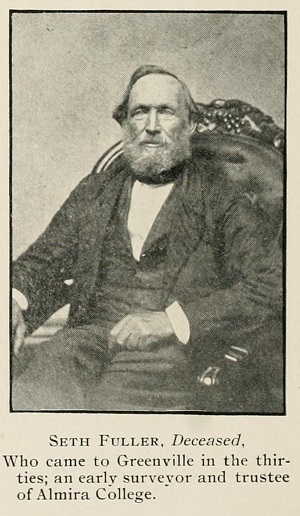
Seth Fuller, Deceased.
Who came to Greenville in the thirties; an early surveyor and trustee of Almira
College.
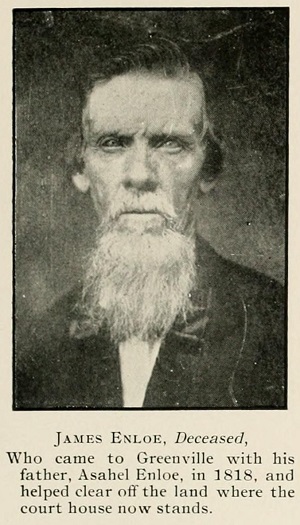
James Enloe, Deceased.
Who came to Greenville with his father, Asahel Enloe, in 1818, and helped clear
off the land where the court house now stands.
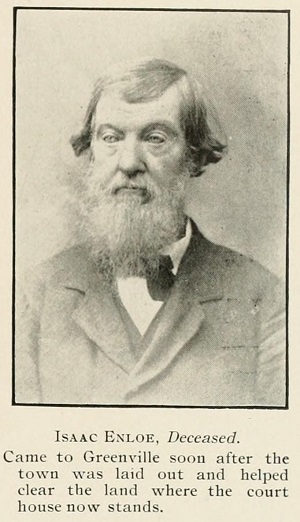
Isaac Enloe, Deceased.
Came to Greenville soon after the town was laid out and helped clear the land
where the court house now stands.
About this time the Reverend Green P. Rice arrived from Kentucky. He bought a
part of George Davidson, 's Ian i and, together with Samuel Davidson, opened the
first store in Greenville. It is said that this store was only large enough to
hold comfortably one wagon load of goods. The store was located on what is now
Main Avenue and Sixth Street. Mrs. Blundell, in her letter, stated that Mr. Rice
became involved in some trouble about some slaves he brought from Kentucky, and,
selling his interests to Cyrus Birge, left the country.
James, Ansel and Cyrus Birge, three brothers, came to Greenville from Poultney,
Vermont. Cyrus kept the store until 1824, when he sold his stock to his brother,
Ansel. who carried on the business for eight years. Ansel Birge, during this
time, married Miss Millicent Clay Twiss, a sister of Willard Twiss, to whom he
sold the store in 1833, and moved to his farm one mile south of Greenville. This
store was the chief public institution of the town, when Greenville became the
county seat in 1821.
Seth, Samuel and Elisha Blanchard came to Greenville in 1820 and entered 1800
acres of land, a part of which is the farm now owned by Mrs. L. K. King, a mile
east of town, at the top of "Blanchard's Hill," which derives its name from
them. They built a cabin in town and opened a store. Seth managed the farm,
Elisha conducted the store and Samuel traded to New Orleans, and they prospered.
Soon after Mr. Blanchard opened the store, travel became more general and a
tavern was opened in connection. A huge pair of antlers, erected over a sign
made of a hewn board, printed with a coal from the hearth, announced the welcome
news that here was the "Buck and Horn Tavern." This institution with a few other
log cabins formed the original town of Greenville. David Berry later became
owner of the tavern and then it passed into the hands of Thomas Dakin, who owned
it many years.
There were no saloons in Greenville in those days, but the merchants all kept
whiskey and treated the customers, who called for it.
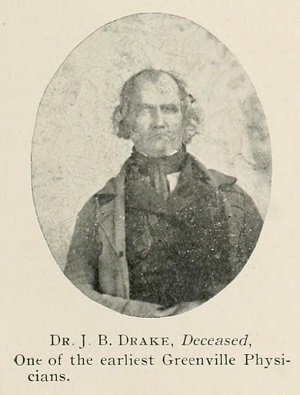
Dr. J. B. Drake, Deceased,
One of the earliest Greenville Physicians.

The Drake House, Built by Dr. J. B. Drake in the early thirties, and dismantled
in 1905.
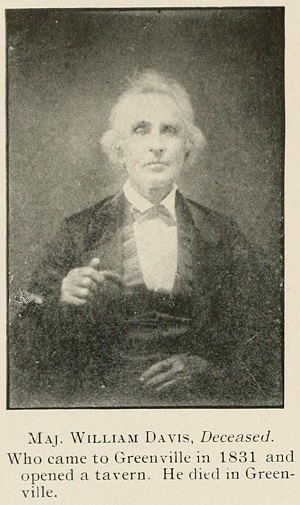
Maj. William Davis, Deceased.
Who came to Greenville in 1831 and opened a tavern. He died in Greenville.

Mrs. Lucy Davis, nee Mayo,
Wife of Major Wm. Davis. Died in Greenville in 1891.
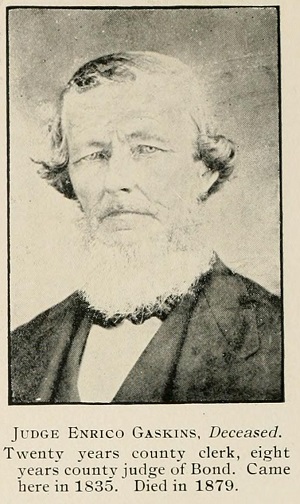
Judge Enrico Gaskins, Deceased.
Twenty years county clerk, eight years county judge of Bond. Came here in 1835.
Died in 1879.
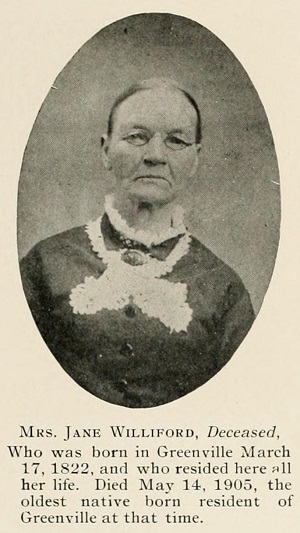
Mrs. Jane Williford, Deceased.
Who was born in Greenville March 17, 1822, and who resided here all her life.
Died May 14, 1905, the oldest native born resident of Greenville at that time.
In the summer of 1818, many families, including Samuel White and George Donnell,
moved here from North Carolina and Kentucky. The principal families in
Greenville then were, in addition to those already mentioned, the Kirkpatricks,
Camps, Goss, Rutherfords, Fergusons and old Father Elam, who lived where the old
graveyard is now located. At his home were held the religious meetings, which
always ended with the minister shaking hands with everybody during the singing
of the last song.
Good Old Father Asahel Enloe was the singing school teacher and the school
master, and many a time in early days, did the youngsters of Greenville
willingly obey his dictum, as he stood in the doorway of the school house and
cried, "Books, books, come to books." His copies were equal to Spencer's best
copper plate and his chirography is still well preserved in the county records.
In a letter dated at Paola, Kansas, June 20, 1876, Mrs. Almira Morse, one of the
best known women the city has produced, and for whom Almira College was named,
stated that the first school house in Greenville was on the northeast corner of
the public square. The square was laid out in 1821, and Samuel Blanchard
assisted John Russell in making the survey. Mrs. Morse says:
"Once a year came 'Parade Day,' when Colonel Stout, accoutered in regimentals,
epaulets and white cockade, mounted on a charger, was marshal of the motley
company.
"There was one colored family in the place. Old Aunt Fanny, with her three
children, bought her freedom of her master in Kentucky, and in Greenville earned
a good living by washing and nursing. One day while she was washing at Mr.
Blanchard's two men suddenly rode up on horseback, and demanded Aunt Fanny and
her children, as runaway slaves. She declared she had her free papers at home,
and with prayers and tears, besought them to leave her, but her entreaties were
unheeded and Aunt Fanny was bound to a horse and with her children behind them,
the men rode away. They were armed with rifles, pistols and knives and no one
dared to interfere. When part way to St. Louis, however, a party from Reno
overtook them. The family was rescued and returned home.
"Our town once had a visit from Lorenzo Dow, who stopped at the tavern, and old
Mr. Twiss went over 'to argue him out of his religion,' but the eccentric old
saint got the better of him. He preached upon the hill north of town. He sat in
his chair, while preaching, for two hours or more."
_____
Extractions from Historical Souvenir of Greenville, Illinois: Being a Brief Review of the City from the Time of its Founding to Date, by Will C. Carson, published in 1905, pages 1-12. Contributed 2021 May 20 by Norma Hass.





